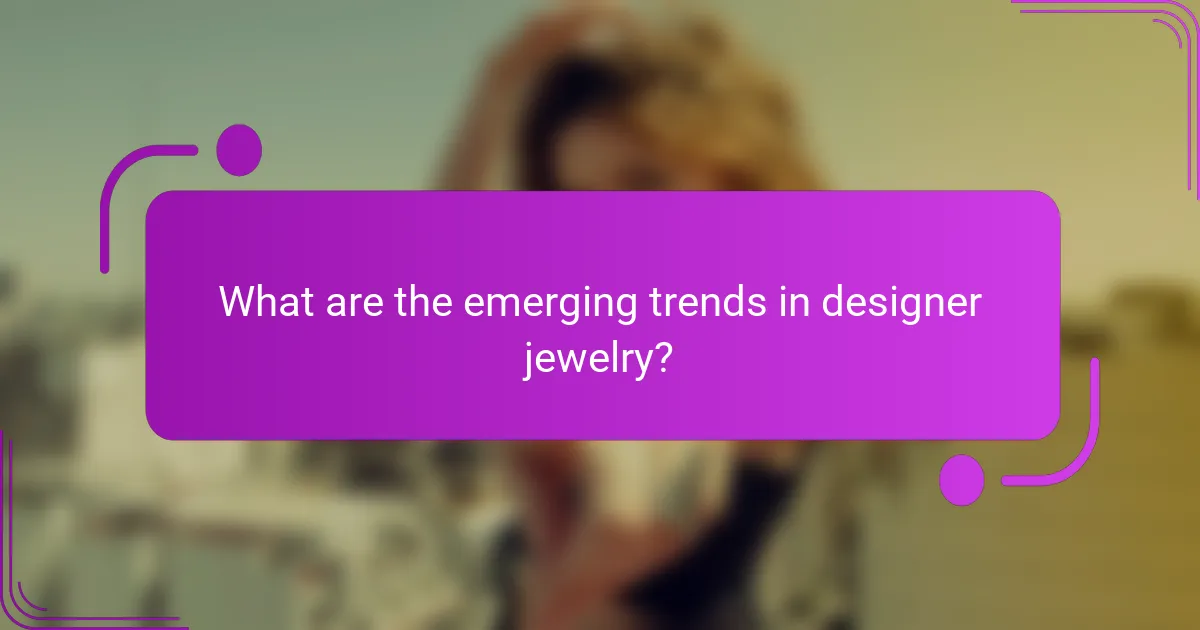The article focuses on emerging trends in the designer jewelry industry, highlighting key concepts such as sustainability, personalization, and technological advancements. Sustainability is increasingly important to consumers, with a preference for ethically sourced materials and environmentally friendly production methods. Personalization trends are rising, allowing customers to create unique jewelry pieces that reflect their individual tastes. Additionally, innovations like 3D printing, smart jewelry, and digital engagement through social media are reshaping the market landscape. These developments indicate a significant shift towards more conscious consumer choices and enhanced shopping experiences in the designer jewelry sector.

What are the emerging trends in designer jewelry?
Emerging trends in designer jewelry include sustainability, personalization, and the use of technology. Sustainability is becoming a priority as consumers seek ethically sourced materials. Brands are adopting recycled metals and lab-grown gemstones. Personalization allows customers to create unique pieces tailored to their preferences. This trend is facilitated by advancements in digital design tools. Additionally, technology integration is on the rise. Smart jewelry that incorporates wearable tech is gaining popularity. The use of 3D printing is also transforming production capabilities. These trends reflect a shift towards more conscious and customized consumer choices in the jewelry market.
How are consumer preferences shaping these trends?
Consumer preferences are significantly influencing trends in the designer jewelry market. Increasing demand for sustainable and ethically sourced materials is reshaping production practices. Many consumers prioritize brands that demonstrate environmental responsibility. This shift has led to a rise in recycled metals and lab-grown gemstones. Personalization is another key trend driven by consumer desires for unique pieces. Customization options allow consumers to express their individuality. Additionally, the popularity of online shopping has changed how consumers discover and purchase jewelry. Brands are now focusing on digital marketing strategies to reach a broader audience. These preferences are driving innovation in design and marketing within the industry.
What specific styles are gaining popularity among consumers?
Minimalist jewelry designs are gaining popularity among consumers. These styles emphasize simplicity and elegance. Many consumers prefer pieces with clean lines and understated aesthetics. Geometric shapes and delicate chains are trending in this category. Additionally, sustainable and ethically sourced materials are increasingly sought after. Consumers are drawn to brands that prioritize eco-friendly practices. Vintage-inspired designs are also making a comeback. These styles often feature intricate details and nostalgic elements. Overall, the shift towards personalization is evident. Customizable jewelry options allow consumers to express their individuality.
How do sustainability and ethical sourcing influence trends?
Sustainability and ethical sourcing significantly influence trends in the designer jewelry industry. Consumers increasingly prefer brands that prioritize environmental responsibility and ethical practices. According to a 2021 survey by McKinsey, 67% of consumers consider sustainability when making a purchase. This shift drives brands to adopt eco-friendly materials and transparent supply chains. Ethical sourcing practices enhance brand reputation and customer loyalty. As a result, many designers are incorporating recycled metals and responsibly sourced gemstones. This trend reflects a broader societal movement towards sustainability in various sectors. Ultimately, sustainability and ethical sourcing shape consumer expectations and industry standards.
What role does technology play in the evolution of designer jewelry?
Technology significantly influences the evolution of designer jewelry. It enhances design capabilities through advanced software and 3D modeling. Designers can create intricate patterns and shapes previously impossible to achieve. Computer-aided design (CAD) allows for precise visualizations before production. Additionally, technology streamlines manufacturing processes. Techniques like 3D printing enable rapid prototyping and customization. This innovation reduces waste and increases efficiency. Furthermore, technology facilitates online sales and marketing. Virtual try-on applications enhance customer experience. These advancements collectively shape the future of designer jewelry, making it more accessible and personalized.
How are 3D printing and digital design transforming the industry?
3D printing and digital design are revolutionizing the jewelry industry by enabling rapid prototyping and customization. This technology allows designers to create intricate designs that were previously impossible to achieve. For instance, 3D printing can produce complex geometries and textures, enhancing aesthetic appeal. Additionally, digital design tools facilitate precise adjustments, allowing for personalized pieces tailored to individual preferences. The adoption of these technologies reduces production time and costs significantly. According to a study by Wohlers Associates, the global 3D printing market is expected to reach $35.6 billion by 2024, indicating widespread industry transformation. Furthermore, brands like Nervous System have successfully utilized 3D printing to create unique jewelry collections, demonstrating practical applications. Overall, these innovations are reshaping how jewelry is designed, produced, and consumed.
What innovations in materials are being introduced?
Innovations in materials for designer jewelry include the use of lab-grown gemstones and recycled metals. Lab-grown gemstones offer identical physical and chemical properties to natural stones. They are produced with less environmental impact and lower costs. Recycled metals reduce the need for mining and promote sustainability. New materials like bio-resins and 3D-printed components are also gaining traction. These materials allow for intricate designs and customization. The adoption of smart materials that change color or temperature is emerging as well. Each of these innovations reflects a shift towards sustainability and personalization in the jewelry industry.

How are consumer preferences evolving in the designer jewelry market?
Consumer preferences in the designer jewelry market are increasingly leaning towards sustainability and personalization. Many consumers now prioritize ethically sourced materials and environmentally friendly production processes. According to a 2021 survey by McKinsey & Company, 67% of consumers consider sustainability when making luxury purchases. Additionally, customization options are gaining popularity, with brands offering bespoke services to cater to individual tastes. Research from Bain & Company indicates that personalized jewelry sales have seen a significant rise, appealing to younger demographics. Furthermore, digital engagement through social media influences buying decisions, as consumers seek authenticity and transparency from brands.
What factors are influencing consumer choices today?
Consumer choices today are influenced by several key factors. These factors include brand reputation, quality, and price. Sustainability has become increasingly important for consumers. Many prefer eco-friendly and ethically sourced products. Social media plays a significant role in shaping consumer perceptions. Influencers often drive trends and brand awareness. Personalization is also a growing demand among consumers. They seek products that reflect their unique identity. Lastly, convenience in purchasing options impacts consumer decisions. Online shopping and fast delivery services are highly valued.
How do brand values and storytelling impact consumer loyalty?
Brand values and storytelling significantly enhance consumer loyalty. When brands clearly communicate their values, they resonate with consumers who share similar beliefs. This alignment fosters an emotional connection, making consumers more likely to remain loyal. Effective storytelling further deepens this bond. It creates relatable narratives that engage consumers, making them feel part of the brand’s journey. According to a study by Harvard Business Review, emotionally connected customers are more than twice as valuable as highly satisfied customers. By intertwining values and stories, brands can cultivate a loyal customer base that transcends mere transactions.
What demographic shifts are affecting the jewelry market?
The jewelry market is being significantly affected by demographic shifts such as aging populations and changing consumer preferences. Millennials and Gen Z are increasingly becoming key consumers, prioritizing sustainable and ethically sourced jewelry. This younger demographic values personalization and unique designs over traditional luxury. Additionally, the rise of e-commerce is reshaping how jewelry is marketed and sold, appealing to a broader audience. According to a report by McKinsey & Company, younger consumers are driving a shift towards more casual and versatile jewelry styles. These trends indicate a fundamental change in the jewelry market landscape.
How do social media and influencer culture affect consumer preferences?
Social media and influencer culture significantly shape consumer preferences by enhancing brand visibility and credibility. Influencers often showcase products to large audiences, creating a sense of trust. According to a 2021 survey by HubSpot, 70% of teenagers trust influencers more than traditional celebrities. This trust translates into purchasing decisions. Additionally, social media platforms allow for immediate feedback and engagement, influencing consumer perceptions. A study by Nielsen found that 92% of consumers trust recommendations from individuals over brands. This indicates that influencer endorsements can lead to increased sales and brand loyalty. Influencer culture also promotes trends rapidly, making certain products desirable. As a result, the interplay between social media and influencers drives consumer behavior in a dynamic manner.
What platforms are most influential in shaping jewelry trends?
Social media platforms are the most influential in shaping jewelry trends. Instagram is particularly significant due to its visual nature. It allows brands to showcase their designs effectively. Pinterest also plays a crucial role by serving as a source of inspiration for consumers. TikTok has emerged as a powerful platform for trend discovery among younger audiences. Influencers on these platforms can rapidly popularize specific styles. Additionally, Facebook groups foster communities that discuss and share jewelry trends. These platforms collectively drive consumer preferences and industry innovations in jewelry.
How do influencers impact purchasing decisions in designer jewelry?
Influencers significantly impact purchasing decisions in designer jewelry. Their endorsements create a sense of trust and credibility among consumers. Research shows that 49% of consumers rely on influencer recommendations for product purchases. Influencers often showcase designer jewelry in aspirational contexts, enhancing its desirability. This visual representation influences consumer perceptions of value and exclusivity. Additionally, influencer collaborations can lead to limited-edition collections, driving urgency in purchasing. The social media platforms they use amplify their reach, exposing their followers to new trends. This exposure can result in increased brand awareness and higher sales for designer jewelry brands.

What innovations are driving the designer jewelry industry forward?
Technological advancements are driving the designer jewelry industry forward. Innovations such as 3D printing allow for intricate designs that were previously impossible. Sustainable practices are increasingly being adopted, with many brands using recycled materials. Customization options have expanded, enabling consumers to personalize their jewelry. Digital platforms enhance customer engagement and streamline the shopping experience. Virtual reality and augmented reality are being utilized for virtual try-ons. Blockchain technology is improving transparency in sourcing and authenticity. These innovations collectively reshape the designer jewelry landscape, appealing to modern consumer preferences.
How are traditional craftsmanship and modern technology being integrated?
Traditional craftsmanship and modern technology are being integrated through the use of digital tools and techniques. Artisans now employ computer-aided design (CAD) software to create intricate jewelry designs. This technology allows for precise measurements and complex shapes that were difficult to achieve by hand. Additionally, 3D printing is utilized to produce prototypes quickly. This process enables designers to test forms before final production. Furthermore, traditional handcrafting techniques are enhanced by laser cutting and engraving. These methods provide consistency and detail that complement artisanal skills. The combination of these practices leads to innovative designs while preserving cultural heritage. This integration reflects a trend towards merging artistry with efficiency in the jewelry industry.
What are the benefits of combining artisanal techniques with technology?
Combining artisanal techniques with technology enhances craftsmanship and efficiency. Artisanal techniques provide unique, handcrafted qualities that appeal to consumers seeking individuality. Technology streamlines production, reducing time and costs. This combination allows for intricate designs that might be difficult to achieve manually. For instance, 3D printing can create precise molds for jewelry, maintaining the artisan’s vision while speeding up the process. Additionally, digital tools enable artisans to experiment with designs easily, fostering innovation. The result is a product that merges tradition with modernity, attracting a broader market.
How are brands leveraging augmented reality in the shopping experience?
Brands are leveraging augmented reality (AR) to enhance the shopping experience by allowing customers to visualize products in a virtual environment. AR applications enable users to try on jewelry virtually, providing a realistic representation of how pieces look on them. For example, brands like Cartier and Swarovski have developed AR features in their mobile apps. These features allow potential buyers to see how rings or necklaces fit with their style and personal aesthetics. According to a report by Deloitte, 40% of consumers expressed interest in using AR for trying on products. This technology not only increases customer engagement but also reduces return rates, as customers can make more informed purchasing decisions.
What are the key challenges facing the designer jewelry industry?
The key challenges facing the designer jewelry industry include competition from mass-produced alternatives, changing consumer preferences, and rising raw material costs. Competition from mass-produced jewelry affects sales of unique designs. Consumers increasingly seek sustainable and ethically sourced materials. This shift requires designers to adapt their sourcing strategies. Additionally, fluctuating prices of precious metals and gemstones impact production costs. Designers must balance quality with affordability to attract buyers. Lastly, the industry faces challenges in digital marketing and e-commerce adaptation. Many traditional brands struggle to establish a strong online presence.
How do economic factors impact the demand for designer jewelry?
Economic factors significantly influence the demand for designer jewelry. When disposable income rises, consumers are more likely to purchase luxury items, including designer jewelry. Conversely, during economic downturns, spending on non-essential luxury goods declines. For instance, a study by Bain & Company reported a 23% drop in luxury goods sales during the 2008 financial crisis. Additionally, consumer confidence affects purchasing decisions. High confidence levels correlate with increased spending on luxury items. Inflation rates also play a role; higher inflation can reduce purchasing power, leading to decreased demand. Therefore, economic conditions directly shape consumer behavior towards designer jewelry.
What strategies are brands using to overcome these challenges?
Brands are using personalized marketing strategies to overcome challenges in the designer jewelry industry. They leverage data analytics to understand consumer preferences and tailor their offerings. This approach enhances customer engagement and loyalty. Additionally, brands are investing in sustainable practices to meet growing consumer demand for eco-friendly products. They emphasize ethical sourcing and transparency in their supply chains. Collaborations with influencers and designers also help brands reach wider audiences. These partnerships can create unique, limited-edition collections that attract attention. Finally, brands are enhancing their online presence through e-commerce platforms and social media marketing. This strategy allows them to connect with consumers directly and showcase their products effectively.
What best practices should consumers consider when purchasing designer jewelry?
Consumers should consider authenticity verification when purchasing designer jewelry. Authenticity guarantees the value and quality of the piece. Research shows that counterfeit jewelry costs the industry billions annually. Consumers should request certificates of authenticity from reputable sellers. These documents confirm the designer and materials used. Understanding the designer’s reputation is also crucial. Established designers typically have a history of quality craftsmanship. Consumers should compare prices across various platforms. Price discrepancies can indicate potential fakes or overpricing. Lastly, checking return policies is vital. A good return policy reflects the seller’s confidence in their products.
How can consumers assess the quality of designer pieces?
Consumers can assess the quality of designer pieces by examining materials, craftsmanship, and brand reputation. High-quality designer items typically use premium materials such as genuine leather, silk, or precious metals. Consumers should inspect the stitching, seams, and overall finish for signs of meticulous craftsmanship. A reputable designer brand often provides information on sourcing and production practices, which can indicate quality. Additionally, reviews and testimonials from other customers can offer insights into the durability and longevity of the pieces. Understanding the brand’s history and its commitment to quality can also help consumers make informed decisions.
What should consumers know about the resale value of designer jewelry?
Consumers should know that the resale value of designer jewelry can vary significantly. Factors influencing this value include brand reputation, rarity, and condition. High-demand brands like Cartier or Tiffany often retain value better than lesser-known names. Jewelry with unique designs or limited editions tends to have higher resale prices. Additionally, the condition of the piece affects its resale potential; well-maintained items fetch better prices. Market trends also play a role; for example, vintage pieces may appreciate in value over time. According to a 2022 report by the Antique Jewelry Company, certain designer pieces can appreciate by up to 30% in resale value. Understanding these factors can help consumers make informed purchasing decisions.
The main entity of the article is designer jewelry, focusing on its emerging trends, consumer preferences, and industry innovations. Key trends include sustainability, personalization, and technological integration, with consumers increasingly prioritizing ethically sourced materials and unique designs. The article explores how consumer preferences are shaping these trends, the influence of social media and influencers, and the role of innovations like 3D printing and augmented reality in the industry. Additionally, it addresses challenges faced by brands and best practices for consumers when purchasing designer jewelry.